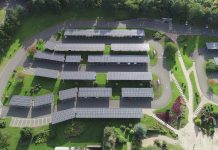PolyU researchers have detailing strategies to accelerate the commercialisation of perovskite/silicon tandem solar cells (TSCs). The goal is to boost efficiency from 34% towards an ambitious 40% milestone, supporting carbon neutrality and high-energy industries like AI
A research team at The Hong Kong Polytechnic University (PolyU) is driving a major push toward commercialising a new generation of energy-efficient solar cells, with the ultimate goal of achieving a 40% energy conversion efficiency milestone. The breakthrough centres on perovskite/silicon tandem solar cells (TSCs), a promising third-generation technology.
The team, including Prof. LI Gang and Prof. YANG Guang from the Department of Electrical and Electronic Engineering, conducted a critical review and comprehensive analysis of TSC performance. Their findings, published in the esteemed journal Nature Photonics under the title “Towards efficient, scalable and stable perovskite/silicon tandem solar cells,” provide strategic recommendations aimed at elevating current maximum efficiencies from approximately 34% to the ambitious 40% target.
This advancement aligns directly with national strategies for carbon neutrality and aims to provide stable, high-efficiency renewable energy, crucial for supporting high-energy-consuming sectors like artificial intelligence.
Overcoming stability and manufacturing hurdles
While lab-scale TSC devices have shown impressive efficiency, transitioning to commercial-scale modules requires addressing significant reliability and manufacturing challenges, according to Prof. Li Gang. The research highlights two primary hurdles:
- Instability: Perovskite materials are inherently vulnerable to environmental factors like moisture, oxygen, UV light, and thermal fluctuation. This instability can lead to efficiency losses over time.
- Scalability and fabrication: Moving from small-area lab devices to large-area commercial modules requires overcoming issues related to uniformity, defect control, and manufacturing methods that align with industrial standards.
The team strongly recommends rigorous, accelerated stability testing, following standardised procedures from the International Electrotechnical Commission, to accurately assess the long-term reliability and commercial potential of these cells.
Sustainable development and collaboration is key
In addition to technical performance, the research addresses environmental concerns. Although perovskite raw materials are relatively low-cost, the frequent use of heavy metal lead in most cell designs presents significant environmental and regulatory issues. The PolyU researchers advocate for developing sustainable material alternatives and establishing efficient recycling or lead sequestration strategies to ensure viable commercialisation.
Prof. Yang Guang emphasised the need for industry-academia-research collaboration through a multidisciplinary approach, integrating material science, device engineering, and economic modelling. This collaborative effort is seen as essential for addressing remaining scientific challenges, achieving lower levelized electricity costs, and accelerating the technology’s transition from the laboratory bench to industrial fabrication.











